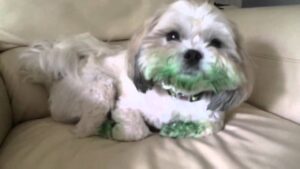It’s natural to worry when your beloved pet ingests something it shouldn’t have. If your dog has eaten paint, you may wonder what to do and whether or not they will be okay. In this article, we’ll delve into what you should know as my dog ate paint, including the potential symptoms, treatments, and preventive measures you can take to avoid similar incidents in the future.
If your dog has ingested paint, seek veterinary care as soon as possible, as paint can be toxic to dogs. Some types of paint contain potentially harmful ingredients such as solvents, heavy metals, and other poisonous substances that can harm your dog if ingested.
The severity of the symptoms and the appropriate treatment will depend on the type of paint ingested, the amount, and the size and health of your dog. Symptoms of paint ingestion may include vomiting, diarrhea, loss of appetite, lethargy, and difficulty breathing. In severe cases, paint ingestion can lead to organ damage or failure.
If you suspect your dog has ingested paint, please immediately contact your veterinarian or a pet poison control hotline for guidance on how to proceed. It is crucial to determine what type of paint was ingested and how much, as this will help your veterinarian determine the appropriate course of treatment.
My dog ate paint

If your dog has ingested paint, it is essential to seek veterinary care as soon as possible. Ingestion of paint can be toxic and cause severe symptoms or even death.
While waiting for veterinary care, you can try to induce vomiting in your dog by giving it hydrogen peroxide. To do this, mix one teaspoon of hydrogen peroxide per 5 pounds of body weight. For example, if your dog weighs 20 pounds, you would give it four teaspoons of hydrogen peroxide.
Be sure to follow the dosage instructions carefully, as giving too much hydrogen peroxide can be dangerous. You can also get your dog to drink water or milk, which may help dilute the paint and reduce the risk of toxicity.
It is important to note that inducing vomiting and giving your dog water or milk is not a substitute for veterinary care. If your dog has ingested paint, contact your veterinarian or an animal poison control center as soon as possible for further guidance and treatment.
Are paint chips toxic to dogs?
Paint chips can be toxic to dogs if ingested. The level of toxicity will depend on the specific type of paint and the amount consumed. Some paints may contain harmful ingredients such as heavy metals, solvents, or other chemicals that can harm your dog’s health if ingested.
Ingestion of paint chips can also cause physical blockages in your dog’s gastrointestinal tract, leading to serious health complications.
Symptoms of paint chip toxicity in dogs may include vomiting, diarrhea, loss of appetite, lethargy, abdominal pain, and difficulty breathing. If you suspect your dog has ingested paint chips, it’s essential to seek veterinary care as soon as possible.
Your veterinarian can determine the best course of action based on the specific circumstances of your dog’s case. This may include inducing vomiting to remove the paint from your dog’s stomach, administering medications to protect their gastrointestinal tract, or providing supportive care such as IV fluids.
To prevent your dog from ingesting paint chips, it’s essential to keep them out of reach and stored correctly in a secure location. It would help if you also were vigilant about cleaning up any paint spills or drips immediately to prevent your dog from coming into contact with them.
If you are working with paint in an area where your dog has access, it’s a good idea to keep them in a separate room or crate to ensure their safety.
How much lead is toxic to a dog?

Ingesting lead can be toxic to dogs and can cause serious health problems. The consumed information can harm dogs at levels as low as 0.1% of their body weight. For example, a toxic dose of lead for a 10-pound dog could be as little as 1 gram.
However, it is essential to note that lead can be toxic to dogs at much lower levels if inhaled, and lead toxicity symptoms can occur at levels as low as 0.25 ppm in the blood.
Symptoms of lead poisoning in dogs may include vomiting, diarrhea, loss of appetite, weight loss, lethargy, muscle tremors, blindness, and seizures. If you suspect your dog has ingested lead or may have been exposed to lead in some other way, it is crucial to seek veterinary care as soon as possible. The sooner treatment is started, the better the chances of recovery.
How much lead is in a paint chip?
The amount of lead in a paint chip can vary significantly depending on the type of paint and when it was manufactured. Prior to 1978, lead was commonly used as a pigment in color, and many older homes and buildings may still have lead-based paint on the walls or other surfaces.
According to the US Environmental Protection Agency (EPA), lead-based paint can contain up to 50% lead by weight. However, the amount of lead in a paint chip can vary based on the specific paint type, the paint’s age, and other factors.
Lead-based paint is considered hazardous and can be harmful if ingested or inhaled. If you are concerned about lead-based color in your home or building, it is vital to have it tested by a professional. The EPA recommends hiring a certified lead-based paint professional to try for and remove lead-based paint safely.
How toxic is paint to dogs?
Paint can be toxic to dogs if ingested or inhaled. The severity of the symptoms and the appropriate treatment will depend on the type of paint ingested, the amount, and the size and health of your dog.
Some types of paint contain potentially harmful ingredients such as solvents, heavy metals, and other toxic substances that can harm your dog if ingested. Symptoms of paint ingestion may include vomiting, diarrhea, loss of appetite, lethargy, and difficulty breathing. In severe cases, paint ingestion can lead to organ damage or failure.
If you suspect your dog has ingested paint, it is crucial to seek veterinary care as soon as possible. The veterinarian will be able to determine the appropriate course of treatment based on the type of paint ingested, the amount ingested, and the size and health of your dog.
What do I do if my dog ate acrylic paint?

Acrylic paint is not toxic to dogs, but it can cause an upset stomach and may cause blockages in the digestive system if ingested in large amounts.
In the meantime, you can induce vomiting by giving your dog a small amount of hydrogen peroxide. You can mix one teaspoon of hydrogen peroxide with one tablespoon of water and administer it orally using a dropper or syringe. Be sure to follow the proper dosage for your dog’s size and weight, as giving too much hydrogen peroxide can be harmful.
It is also essential to monitor your dog closely for any signs of illness or distress, such as vomiting, diarrhea, lethargy, or loss of appetite. If your dog exhibits any of these symptoms, or if you are concerned about its health in any way, contact your veterinarian immediately.
It is always a good idea to keep potentially harmful substances out of reach of pets and keep the number for your veterinarian and the ASPCA Animal Poison Control Center handy in emergencies.
Why is my dog eating paint from the wall?
One reason your dog may be eating paint is that they lack certain nutrients and are trying to satisfy their nutritional needs by eating non-food items. This behavior is known as pica, and several things, including an unbalanced diet, mineral deficiencies, or an underlying medical condition, can cause it.
Another possibility is that your dog is curious and is exploring their environment by tasting and chewing on different objects. This is a normal part of canine behavior, but it can be dangerous if your dog ingests harmful substances.
If your dog exhibits this behavior, it is essential to consult a veterinarian to rule out any underlying medical conditions and determine the best course of action.
In the meantime, you can prevent your dog from accessing the paint by covering or removing it from their reach and providing plenty of safe and appropriate chew toys to redirect their chewing behavior.
What if my dog licks wet paint?

Dogs are not recommended to lick wet paint, as it can be toxic. The paint may contain chemicals that can be harmful if ingested. If your dog licks wet paint, monitoring them for any signs of discomfort or illness, such as vomiting, diarrhea, lethargy, or difficulty breathing, is crucial.
If you notice any of these symptoms, it is essential to contact your veterinarian right away. In the meantime, you can prevent your dog from licking the paint by keeping them away from the area where the paint is being applied. Ensure that all surfaces have completely dried before allowing your dog access.
Why does my dog eat paint?
There may be several reasons why your dog is eating paint. It is possible that your dog is experiencing a deficiency in certain nutrients, such as minerals or vitamins, and is trying to compensate by eating non-food items. It is also possible that your dog is experiencing anxiety or boredom and is using paint-eating to cope with these feelings.
Identifying the underlying cause of your dog’s paint-eating behavior and addressing it to prevent any further incidents is essential.
This may involve modifying your dog’s diet, providing more mental and physical stimulation, or addressing any underlying medical conditions. In the meantime, it is crucial to keep all paint and other potentially toxic substances out of your dog’s reach to prevent any accidental ingestion.
How do I stop my dog from eating paint?
It’s vital to keep paint and other household chemicals out of reach of pets to prevent accidental ingestion. Here are some steps you can take to prevent your dog from eating paint:
Keep the paint out of reach
Make sure to securely store paint and other household chemicals where your dog cannot access them. This could be a locked cabinet or a room your dog cannot enter.
Keep an eye on your dog
When using paint, keep an eye on your dog to ensure that they do not try to lick or chew on the paint.
Use non-toxic paint
If you paint a surface that your dog may come into contact with, consider using a non-toxic paint that is safe for pets.
Clean up any spills immediately
If you spill some paint, clean it up immediately to prevent your dog from coming into contact with it.
Why do dogs lick paint?

Dogs may lick paint for a variety of reasons. Some dogs may lick paint out of curiosity or because it has an appealing smell or taste. Dogs have a strong sense of smell and may be attracted to the scent of the paint.
Some types of paint may also contain appealing ingredients to dogs, such as sweeteners or other palatable substances.
It is vital to keep paint and paint supplies out of reach of dogs to prevent accidental ingestion. If you notice your dog licking paint, it is crucial to remove the paint’s source and seek veterinary care as soon as possible, as paint can be toxic to dogs.
How long after painting a room is it safe for pets?
Keeping pets out of a freshly painted room for at least 24-48 hours is a good idea to allow the paint to dry thoroughly and off-gas any volatile organic compounds (VOCs). This is especially important for oil-based paints, which can take longer to dry and release VOCs for a more extended period. Latex paints, on the other hand, tend to dry and off-gas VOCs more quickly.
It’s also important to properly ventilate the room during and after painting to help dissipate harmful fumes. This can be done by opening windows, using fans, or running an air purifier.
If you have a pet with respiratory issues or a compromised immune system, keep them out of the painted room for an extended period. It’s always a good idea to consult with your veterinarian if you have any concerns about the safety of your pets in a freshly painted room.
What paint is safe for dogs?
It is generally recommended to use paints that are non-toxic and low in volatile organic compounds (VOCs) when painting areas that pets have access to. VOCs are chemicals that can evaporate into the air and potentially harm humans and animals.
There are some pet-safe paint options available on the market, including:
- Natural paints are made from plant-based ingredients, such as milk or clay.
- Low-VOC or zero-VOC paints emit fewer harmful chemicals into the air.
- Water-based paints are generally considered safer for pets than oil-based paints.
It is always a good idea to keep pets out of the room while painting and to follow the manufacturer’s instructions for proper ventilation to minimize exposure to fumes. If you are concerned about the safety of a particular paint, you can also check the label or contact the manufacturer for more information.
Is paint harmful to dog paws?
Paint can harm dog paws if it is ingested or comes into contact with your dog’s skin and is not properly cleaned off. Some types of paint may contain toxic ingredients such as heavy metals, solvents, or other chemicals that can be harmful if ingested or absorbed through the skin.
Ingestion of paint can lead to serious health complications, including gastrointestinal irritation, vomiting, diarrhea, and difficulty breathing.
If your dog’s paws come into contact with paint, cleaning them off as soon as possible is essential to prevent ingestion or absorption. You can gently use a damp cloth or paper towel to wipe their paws.
Avoid using soap or other cleaning products, as these could harm your dog if ingested or absorbed through the skin. If the paint has already dried on your dog’s paws, you may need to use a small amount of mild soap and water to help remove it.
If you are concerned that your dog has ingested paint or that the paint has come into contact with their skin and you are unable to clean it off, it’s essential to seek veterinary care as soon as possible.
Is it okay to paint with a dog in the house?
It is generally not recommended to paint with a dog in the house, as paint fumes and particles can be harmful to pets. Most types of paint release volatile organic compounds (VOCs) as they dry, and these fumes can be dangerous if inhaled.
In addition, paint particles can settle on your dog’s fur and skin, and your dog may ingest them if they groom themselves.
If you must paint with your dog in the house, there are a few precautions you can take to reduce the risk of harm to your pet:
- Keep your dog in a separate, well-ventilated room that is not being painted.
- Use low- or no-VOC paint to reduce the number of fumes released into the air.
- Open windows and doors to help ventilate the room and reduce the concentration of paint fumes.
- Use a fan to help circulate the air and disperse the fumes.
- Keep your dog away from freshly painted surfaces and any paint supplies.
If you are concerned about the safety of your pets while painting, it is best to consult with your veterinarian or a pet poison control hotline for guidance.
Conclusion
In conclusion, it is vital to be vigilant about the potential dangers that can be present in your home, especially when it comes to your pets. If you suspect your dog has ingested paint, it is crucial to seek immediate medical attention, as paint can be toxic to dogs and cause serious health complications.
While it can be difficult to prevent all accidents, taking steps to secure any potentially harmful substances and being aware of your dog’s behavior and surroundings can help to reduce the risk of potential ingestion.
When my dog ate paint, it is crucial to act quickly and consult with a veterinarian to ensure the best possible outcome for your furry friend.

